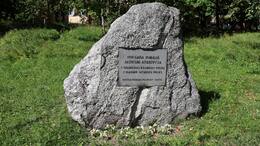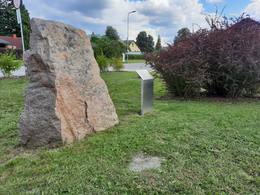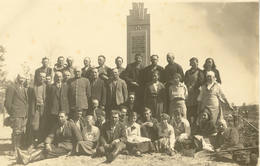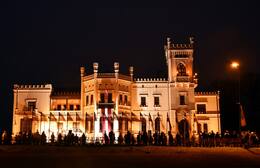About the Latvian War of Independence and the events of 1918 in Alūksne
In 1918, when German troops entered Alūksne, the Latvian rifle battalions retreated to Soviet Russia. By the beginning of December 1918, a German regime was established and reorganizations were carried out. After Germany surrendered in the war, the Bolsheviks returned to Alūksne and restored their power. Finnish volunteers also fought as part of the Estonian army in the Latvian War of Independence. On February 21, 1919, fierce battles took place between the Bolsheviks and the Finnish volunteer regiment “Northern Boys” in Alūksne, near the station.
“In the autumn of 1918, the Germans hastily retreated from Alūksne, as revolution had also broken out in Germany. Soviet power had risen again in Alūksne. The Germans had left many bottles of alcoholic beverages in the shop on Bremžu Street. The Red Riflemen carried the bottles into the yard and smashed them on stones. Cheap liqueurs, which the Germans usually exchanged for eggs and bacon from the peasants, now flowed fragrantly down the rink on Vidus Street.
The Executive Committee was located in the Alūksne Castle. As leading employees, I remember Zīlis, Samsons, Egli, Dipāns Ernests, and the chief of the militia, Bukans Augusts.”
“One evening in February 1919, rifle and machine gun fire could be heard, heralding the approach of the front. In Alūksne, at 11 Alsviķu Street, in a small house on a hill, living in a small room, our mother, sister and I watched all the events in the house. During the night, the sound of shooting got closer and closer. The next morning, cannon shells were already howling over our hut and exploding in the meadow behind the bathhouse. The snow turned black in the explosion holes. In the afternoon, armed Finnish White Guards came down Alsviķu Street. In white winter hats and brown winter boots with their muzzles turned up. They entered our poor room, looked around and left. Terror began in Alūksne. (..) A terrible sight opened up on the station hill. There were many fallen people all around in the snow, some even sons of Chinese nationality. (..) A damaged armored train was located at Alūksne station. (..) A few days later, the Baltos carried the fallen heroes piled on sledges to the Alūksne Castle square, where they were buried without coffins in two long common pits. (..) The Executive Committee evacuated from Alūksne Castle. The Red Army units also left Alūksne.”
Memories of Artūrs Kļava. Collection of the Alūksne Museum. ANM 1701.
Artūrs Kļava. Letter to the Alūksne Museum, December 21, 1961.
Related timeline
Related objects
Memorial stone to the liberators of Alūksne
Located in Alūksne, at the intersection of Helēnas and Alsviķu streets.
The memorial stone was unveiled on May 29, 1999, on the 80th anniversary of the liberation of Alūksne. The stone carving work was carried out by sculptor Ainārs Zelčs.
On March 31, 1919, the Northern Latvian Brigade was founded in the city of Tartu, with the task of liberating Vidzeme and Latgale. The brigade consisted of the combined 1st Valmiera and 2nd Cēsis Infantry Regiments, later also the Northern Latvian Partisan Regiment, two cavalry squadrons and two artillery batteries. On May 26, these forces occupied Valmiera, but on May 27, the 1st Valmiera Infantry Regiment, together with the 2nd Estonian Cavalry Regiment, launched an attack in the direction of Alūksne. The Bolsheviks were unable to repel further attacks, and on May 29, 1919, Alūksne was liberated.
Memorial stone to the Finnish volunteer regiment "Boys of the North"
Located in Alūksne, at Jāņkalna Street 52, near the Alūksne narrow-gauge railway station.
On February 23, 2019, to mark the centenary of the Latvian War of Independence, at the initiative of the Independence Struggle Traditions Association (Finland), a special memorial site was created to honor the Finnish volunteers who fell for Latvia's independence, where a special boulder and an information plaque testify to the historical events. The memorial stone traveled to Alūksne from Finland - the Salpa Line, which was built in 1940-1944 to protect Finland's Eastern border. The 1,200 km long Salpa Line is one of the most notable defense lines of independent Finland, as well as one of the strongest and best-preserved defense structures of this type in Europe after World War II.
The stone brought to Alūksne symbolizes the struggle of two peoples - the Finns and the Latvians - for their independence. The Finnish volunteer regiment "Boys of the North" went to help the Latvians protect the freedom of the new Latvian state. On February 21, 1919, the "Boys of the North" participated in fierce battles in the vicinity of Alūksne (Marienburg). After a five-hour battle near the Alūksne railway station, the Finns took Alūksne. In this battle, 23 Finnish volunteers lost their lives and many were wounded.
Monument to the soldiers of Anna Parish who fell in World War I and the Latvian Liberation War
Located in the central part of the Ezeriņi cemetery in Anna parish.
In the cemetery, where burials have been held since 1925, there is a monument erected with funds collected by the Annas parish Guards Department and opened in 1933 to the soldiers of Annas parish who fell in World War I and the Latvian Liberation War. Until World War II, the Annas parish guards took care of the maintenance of the monument, who went to the cemetery every Sunday and, honoring the fallen, laid flowers. On November 18, 1940, the monument was shot down, the traces left by the bullets are still visible. Nowadays, commemorative events dedicated to Lāčplēsis Day are held in the cemetery every year.
In 2004, a memorial site was opened in the cemetery for those politically repressed in 1941 and 1949, and in 2006, a memorial plaque was opened for national partisans.
Alūksne Museum
The Alūksne Museum is located in an architectural monument of national significance: the neo-Gothic Alūksne New Castle built in the late 19th century. The museum features an exhibition named ‘Memorial Room for Victims of the Totalitarian Regime’, which tells about the fate of the inhabitants of Alūksne municipality in Siberia and the Far East, while the time periods from prehistory to the present meet in the Alūksne history exhibit ‘Feast of the Ages’. It features a separate section devoted to the contribution of the 7th Sigulda Infantry Regiment to the military, culture and public life. The formation of the 7th Sigulda Infantry Regiment began on 20 June 1919 in the Naukšēni Manor. Initially, a battle group of 22 officers and 1,580 soldiers was formed from the reserve battalion of the Northern Latvian Brigade, and was named the Dankers Division. It was included in the 2nd Battalion of the 3rd Jelgava Regiment. On 23 August, following an increase in the number of companies, it became part of the 7th Sigulda Infantry Regiment. Having taken part in the battles against Bermondt, on 5 January 1920, the regiment was transferred to the Latgale front to fight the Bolsheviks. After the signing of the Peace Treaty with Soviet Russia, the regiment guarded Latvia’s eastern border. The Latvian War of Independence saw the deaths of more than 200 soldiers of the regiment, while 85 were awarded the Lāčplēsis War Order. In 1921, the 7th Sigulda Infantry Regiment was stationed in Alūksne. The regiment’s headquarters were set up in the Alūksne New Castle. After World War II, the castle was taken over by Soviet security institutions. As of the late 1950s, the castle housed various cultural institutions: the Culture and Cinematography Department of the Executive Committee, a pioneer house, a library, a cinema and a museum.








